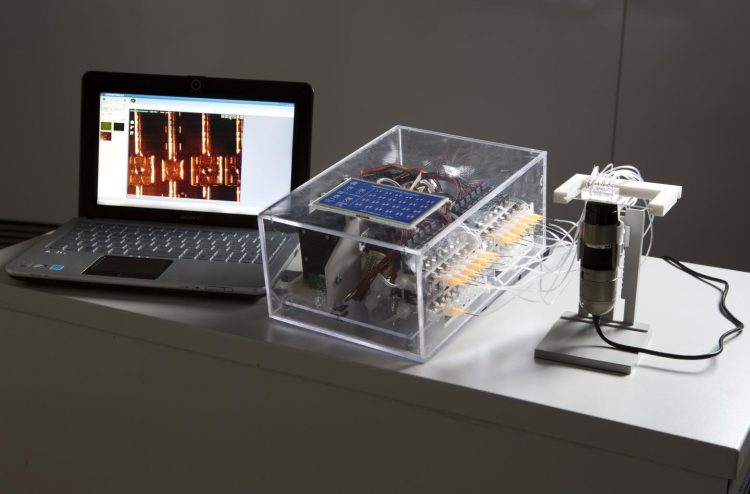A portable device for rapid and highly sensitive diagnostics

The microfluidic tool has been tested with Ebola. It requires no bulky equipment, and is thus ideally suited for use in remote regions. Credit: Alban Kakulya
Over the past several years, microfluidic devices have shown extraordinary potential in the area of diagnostics. They are composed of silicone rubber with minuscule channels the width of a hair. Microfluidic devices, and can rapidly detect a number of different biomarkers in very small quantities of blood.
At EPFL, a new type of microfluidic platform has come out of the Laboratory of Biological Network Characterization (LBNC), headed by Sebastian Maerkl. It is a portable device that runs on battery power and is completely self-sustained. It operates seamlessly with inexpensive microscopes and provides very high levels of accuracy and detection. The platform, which is described in a recent ACS Nano article, can quantify up to 16 different molecules – or biomarkers – in a tiny amount of blood (less than 0.005 milliliters). The biomarkers are usually enzymes, proteins, hormones or metabolites and the concentration of these molecules in the blood provides precise information on the patient's health condition.
Two detection readouts in one platform
The device is unique in that it is composed of both analog and digital detection mechanisms, while conventional devices hitherto only integrated one or the other. Digital detection is highly sensitive and can detect the presence of a single biomarker. However, it is less effective when the concentration of biomarkers is too high, due to signal saturation. Analog measurements, on the other hand, function best at higher biomarker concentrations. Using these two detection mechanisms simultaneously, the composition of a drop of blood can be thoroughly analyzed in a short amount of time. The analysis provides precious medical information: it could help doctors make an early diagnosis or determine the stage of a disease.
Initial testing has been successfully carried out on a sample containing anti-Ebola antibodies, which indicate the presence of the virus in both symptomatic and asymptomatic patients. The device could potentially work with a large number of other protein biomarkers and molecules.
No need to pre-treat blood samples
There is more good news. Researchers at EPFL found that they could load the blood sample directly onto the device and perform on-chip biomarker quantitation without requiring any sample pre-treatment. “For researchers, it is quite interesting to be able to avoid having to separate the blood,” said Francesco Piraino, the article's lead author. Blood plasma separation requires centrifuges, large volume samples and a long processing time.
For diagnoses in resource-limited regions
Says Piraino: “The platform will lead the development of new kinds of tests to meet the increasing demand for on-site diagnostic testing. It will prove very useful for medical staff working in resource-limited regions.” The device could, for example, be used to monitor endemic, epidemic, and pandemic disease outbreaks.
Media Contact
All latest news from the category: Medical Engineering
The development of medical equipment, products and technical procedures is characterized by high research and development costs in a variety of fields related to the study of human medicine.
innovations-report provides informative and stimulating reports and articles on topics ranging from imaging processes, cell and tissue techniques, optical techniques, implants, orthopedic aids, clinical and medical office equipment, dialysis systems and x-ray/radiation monitoring devices to endoscopy, ultrasound, surgical techniques, and dental materials.
Newest articles

Combatting disruptive ‘noise’ in quantum communication
In a significant milestone for quantum communication technology, an experiment has demonstrated how networks can be leveraged to combat disruptive ‘noise’ in quantum communications. The international effort led by researchers…

Stretchable quantum dot display
Intrinsically stretchable quantum dot-based light-emitting diodes achieved record-breaking performance. A team of South Korean scientists led by Professor KIM Dae-Hyeong of the Center for Nanoparticle Research within the Institute for…

Internet can achieve quantum speed with light saved as sound
Researchers at the University of Copenhagen’s Niels Bohr Institute have developed a new way to create quantum memory: A small drum can store data sent with light in its sonic…





















